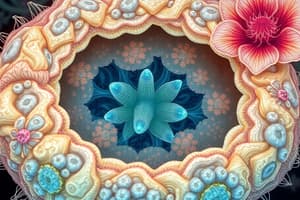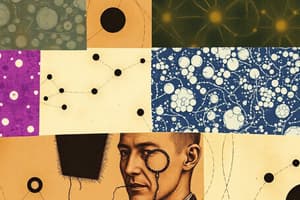Podcast
Questions and Answers
Which structure is primarily responsible for the photosynthesis process in plant cells?
Which structure is primarily responsible for the photosynthesis process in plant cells?
- Chloroplasts (correct)
- Mitochondria
- Nucleus
- Endoplasmic reticulum
What distinguishes animal cells from plant cells?
What distinguishes animal cells from plant cells?
- Plant cells have larger vacuoles. (correct)
- Plant cells contain chloroplasts. (correct)
- Animal cells can produce their own food.
- Animal cells have a cell wall.
Identify the function of a ciliated cell in an organism.
Identify the function of a ciliated cell in an organism.
- Provide immunity against pathogens.
- Transport oxygen in the blood.
- Support plant structure.
- Facilitate movement of substances over surfaces. (correct)
Which of the following terms best describes a group of similar cells working together?
Which of the following terms best describes a group of similar cells working together?
What process is responsible for the creation of new cells?
What process is responsible for the creation of new cells?
What is a primary structural characteristic of bacterial cells compared to animal and plant cells?
What is a primary structural characteristic of bacterial cells compared to animal and plant cells?
Which specialized cell is primarily adapted for absorption of water and minerals in plants?
Which specialized cell is primarily adapted for absorption of water and minerals in plants?
Which term best describes a collection of different tissues working together to perform a specific function?
Which term best describes a collection of different tissues working together to perform a specific function?
What is the primary function of neurones in the body?
What is the primary function of neurones in the body?
What structure distinguishes plant cells from both animal and bacterial cells?
What structure distinguishes plant cells from both animal and bacterial cells?
Flashcards
Cell
Cell
The basic building block of living things.
Plant cell
Plant cell
A type of cell that forms plants, having a cell wall and chloroplasts.
Animal cell
Animal cell
A type of cell that forms animals, lacking a cell wall and chloroplasts.
Bacterial cell
Bacterial cell
Signup and view all the flashcards
Cell structure
Cell structure
Signup and view all the flashcards
Tissue
Tissue
Signup and view all the flashcards
Organ
Organ
Signup and view all the flashcards
Organ system
Organ system
Signup and view all the flashcards
Organism
Organism
Signup and view all the flashcards
Ciliated cells
Ciliated cells
Signup and view all the flashcards
Root hair cells
Root hair cells
Signup and view all the flashcards
Palisade mesophyll cells
Palisade mesophyll cells
Signup and view all the flashcards
Neurons
Neurons
Signup and view all the flashcards
Red blood cells
Red blood cells
Signup and view all the flashcards
Gametes
Gametes
Signup and view all the flashcards
Plant cell structure
Plant cell structure
Signup and view all the flashcards
Magnification
Magnification
Signup and view all the flashcards
Cell size
Cell size
Signup and view all the flashcards
Cell slice thickness
Cell slice thickness
Signup and view all the flashcards
Cell function
Cell function
Signup and view all the flashcards
Ciliated cells
Ciliated cells
Signup and view all the flashcards
Root hair cells
Root hair cells
Signup and view all the flashcards
Palisade mesophyll cells
Palisade mesophyll cells
Signup and view all the flashcards
Neurons
Neurons
Signup and view all the flashcards
Red blood cells
Red blood cells
Signup and view all the flashcards
Gametes
Gametes
Signup and view all the flashcards
Study Notes
Chloroplasts
Chloroplasts are organelles in plant cells responsible for photosynthesis, containing chlorophyll that absorbs sunlight to convert carbon dioxide and water into glucose and oxygen.
Distinguishing Plant and Animal Cells
Plant cells have a rigid cellulose cell wall, chloroplasts, and a large central vacuole for storage, while animal cells lack cell walls and chloroplasts, with smaller vacuoles.
Ciliated Cells
Ciliated cells have hair-like cilia that beat rhythmically to move fluids in the respiratory and reproductive systems.
Tissues
Tissues are groups of similar cells performing specific functions, including epithelial (protective barrier), muscle (movement), nervous (information transmission), and connective (support).
Cell Division
Cell division, primarily mitosis, is the process of creating new cells from existing ones, ensuring growth, repair, and reproduction.
Studying That Suits You
Use AI to generate personalized quizzes and flashcards to suit your learning preferences.





